Blog Posting Guidelines
Repurposing long-form video content into engaging articles is a great way to improve your visibility (SEO) and maximize your reach by catering to people who prefer reading rather than watching videos. This is part of the second stage in the Content Factory—"Process."
In this tutorial, you'll learn how to transcribe a pre-recorded video and structure an article that effectively captures all the key points from the original video.

Important Note
Task Checklist
Information You Will Need:
- The client's Goals, Content, and Targeting (#GCT).
- The RAW video file that serves as the pillar content.
Tools You Will Need:
- Any text editor, such as Google Docs or MS Word.
- Any AI transcription software, such as Descript (access should be requested through the proper channels).
Steps:
Before You Start Writing
1. Upload the video to Google Drive
2. Watch the video
3. Transcribe the video
Writing and Editing Phase
4. Edit the transcription
5. Add title and headings
6. Include images
7. Insert relevant links
8. Add source context (video, post, brief)
9. Proofread and QA your work
After You Finish Writing
10. Publish on WordPress
11. Categorize and keyword-tag
12. Apply SEO Plugins (RankMath and LinkWhisper)
Additional Steps
13. Email and DM the client
14. Post in our 43K Facebook group
15. Important considerations
Estimated time it takes on average to post an article on your website about pillar content: A 60-minute recording would take about 3 hours.
Before You Begin...
Consider how the second stage of the Content Factory, "Process," differs from the first stage, "Produce." Understanding this difference is crucial before you are able to repurpose a long-form video successfully.
As a content VA, you are not supposed to add your own perspective or ideas to the article you create by repurposing a video. Your role is to transform the raw footage, featuring an industry expert discussing a specific subject, into a written article. This process adheres to Google's EEAT (Experience, Expertise, Authority, Trust) protocol because the content originates from a knowledgeable source (industry expert), not the VA, ensuring all our content meets these standards.
A common issue is when VAs make the #1 VA mistake and mindlessly use ChatGPT to repurpose a video's transcript into an article, without first understanding the video. This results in a generic article, that might look good at first glance, but is vague and strays far from the actual message in the video.
To prevent this, it is crucial to understand the Goals, Content, Targeting (#GCT) of any content that you touch: What is your intended outcome (Goal)? What supports the goal, content-wise, (Content), and who benefits from the message (Targeting)? To understand this, watch this short video clip about #GCT, which is one of the triangles in our 9 Triangles Framework.
The most rampant vandalism that is occurring inside our company is VAs that are gleefully posting items while being completely unaware of what we already have. This issue arises when VAs use the same source material to create multiple articles or create new articles targeting the same keyword, without realizing that all our content should fit together like a tree, where smaller topics branch out from main ones.
When VAs repurpose each video into a new article without checking for an existing article on the same topic, it leads to unnecessary duplication that doesn’t add new value. Instead, they should be enhancing the existing content with new video insights, creating new articles only when there is a new term to target.
We’ve tried to solve this problem by clearly explaining in our SEO training that each page should focus on one unique keyword to avoid having many pages competing for the same keyword. This effort is part of our strategy to prevent what we call 'chronic vandalism' in content creation.
1. Upload the Video to Google Drive
After creating the task on BaseCamp or a similar project management tool, upload the video to the designated folder and sub-folder on our Google Drive, as outlined in the guide for this task.
2. Watch the Video
Before you transcribe a video, it's really important to watch the video first. Here's why: watching helps you understand what's happening, where to put pauses and emphasis, who is talking, if the sound is good, what the words mean, how to fill in missing parts, get what the speaker wants to say, check if the content is okay, and match up the words with the video timing.
In short, watching ensures you get the GCT (goals, content, targeting) right, vital for an accurate and meaningful transcription.
3. Transcribe the Video (Pillar Content)
Most long-form content is not of high-enough authority to warrant using Descript and other tools. In other words, we can often post low-authority content (not by figureheads, not filmed professionally, not spoken clearly, with no clear proof, etc.) without transcription (just cutting off the ends and posting).
With Descript, we're on their enterprise plan (the highest one), which is necessary to use OverDub voices.
Descript's transcriptions are white glove ($2 a minute) and self-serve (7 cents per minute if we do the $20/month fee).
a. Confirm that nobody else has transcribed the video. To do this, check the Video Edit Queue Sheet and search for the file title you have.
-
- IF the file name is there, THEN check the “Transcription” column, and see if there is a link to a document. If there is, open the file, and see if the File is indeed correct.
- IF there are 0 results in the search box, proceed to further steps.
b. Access the transcription software by logging in using LastPass and clicking "Launch" on Descript.

c. The Descript application will then open in another tab with the Username and Password Filled out, and you just need to click the “Next” button.
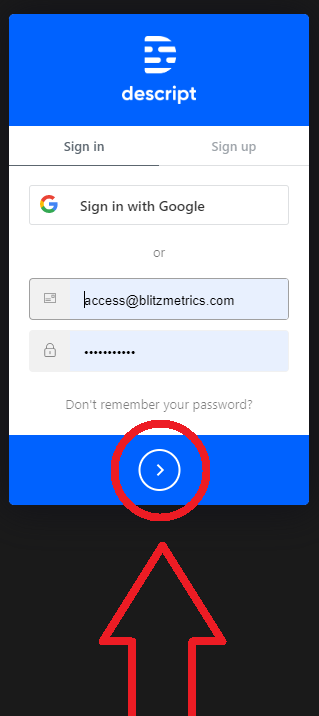
d. You'll be in the "Creator's Drive," but you need to access the "Overdub Drive." To do this, click on the "Creator's Drive," and a dropdown menu will appear. Select "Overdub Drive."
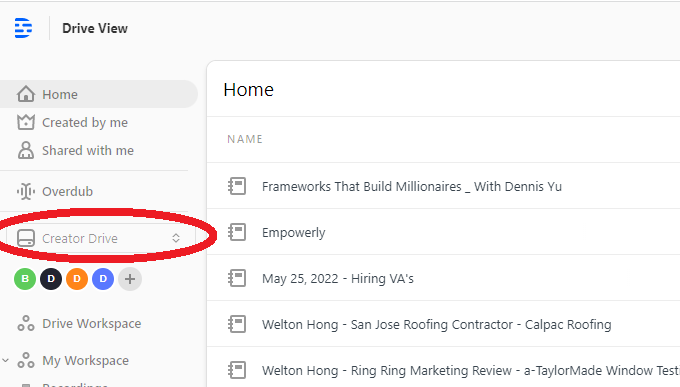
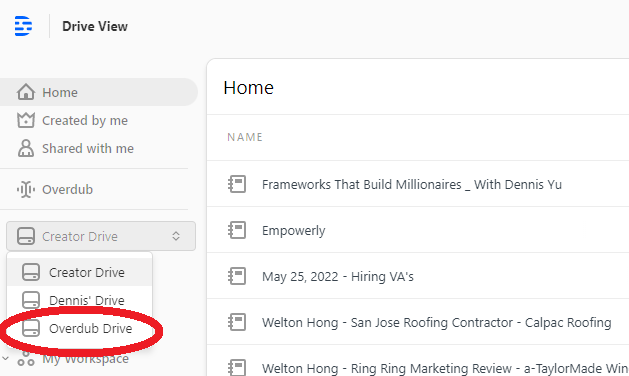
e. Click + New Project.

f. Name the file in the Untitled Project area. Make sure to choose Overdub Drive > Drive Workspace.

If you are not in the Overdub Drive or the Drive Workspace, you can navigate through the folders and drives by clicking the arrow icons.
|
IF |
THEN |
|
The file is for a client. |
Use the syntax client’s name- video title, (e.g. Conan O'brien - Caring For Your Pompadour, Aisa Jones - Dirt On Trial, Greg Perez - The Watcher). |
|
The file is for a course, program, or presentation. |
Use the syntax course/program/presentation name - video title, (e.g. Agency Management Program - 9 Triangles) |
|
The file is for a package |
Use the syntax package name - video title, (e.g. Content Engine Package - Plumbing) |


Click Create Project.
g. Import the RAW video by dragging the file from the source folder to the “Audio” icon in Descript. Descript will then process your transcript. Just click “Done” on the screen below and wait for the transcription to finish.
h. Review the transcript’s words that have blue underlines and correct them manually by right-clicking on each word, and selecting Correct.
i. When the transcription tool has corrected everything, you are then ready to save the transcription. Click on “File” then “Export.”
j. Choose “Text.”
k. Click “Export.”
l. Choose which folder you want the file saved, and click “Save.”
m. Once you have exported the file, save it to the relevant folder inside the Shared Drive.
Sample Result: TikTok Webinar with Perry Marshall
4. Edit the transcription: timestamps and blog post ideas
a. First, watch the entire video and understand its meaning while referring to the transcript, so you can easily identify the important keywords and topics.
Consider these questions to deepen your understanding of the video:
i. What is an engaging title for this content?
ii. What is the core message of this video?
iii. Who is the likely audience for this content?
iv. How many edited videos (or snippets) will be produced from this single raw video?
v. Which sentence would help you establish an immediate connection with the audience (in the very first sentence)?
b. Create a detailed outline that includes up to ten sub-topics.
Typically, each sub-topic corresponds to about 5 to 10 minutes of video content. This duration can vary based on the content type; for example, a podcast may offer numerous sub-topics due to its dense information, whereas an SEO audit video might feature longer discussions with fewer distinct topics.
In your outline, highlight the most engaging or crucial information for each sub-topic. For interviews, you can structure each sub-topic around individual questions.
Remember, instead of assigning a new heading to each sub-topic, group similar sub-topics logically under broader headings, spacing them effectively to prevent an overload of headings.

c. Make sure the content is evergreen.
Avoid including specific events, dates, or promotional sales in the content. This strategy ensures that the article remains relevant for an extended period.
Write the draft article using the transcription
Your article should have at least 200 words. Write clearly and in an active voice. Break up long paragraphs for easier reading.
The following screenshot from the article "Building Relationships and Amplifying Reputation with AI Tools", shows how you can use line breaks to organize an article.

You should also reach out to the blogs you’ve been commenting on, asking them for a few quotes on your topic. Attribute their quote, add their photo/headshot, and link to their website.
Make sure to let them know the article is live via their Twitter or Facebook page so others who follow them can also benefit from their insights (and get a little traffic/awareness to your blog).
5. Give your article a snappy title and headings
Once you have finished the article, it’s time to give it a killer headline that summarizes what it is about and why your audience should read it.
It helps to lay out the numbers, what they mean, and how the reader benefits from them, such as “I have 602 Sales Reps Right Now Making Just Over $1 a Day” by Logan Young. Look over the following articles for some examples:
- How to write headlines at https://copywritingcourse.com/how-to-write-headlines/
- The Ultimate Idea-Inducing Creativity-Enhancing Sample Headline Collection
Here are some examples of titles that you can get from yourcontentfactory.com/blog.

In the body, stick to H2s and H3s for headings in WordPress. H2s are subheadings for H1s - which is typically the main title; and H3s are subheadings for H2s.
The headings should always:
- Be brief and grab attention, as readers often skim.
- Motivate readers to read on.
- Sum up the following section's main idea.
- Be used sparingly to avoid clutter. Check for heading abuse. This means using a new heading for every 3 to 4 lines of text. This is common with ChatGPT generated articles. Adjust the number of headings based on top search results, using tools like Surfer or Frase for SEO advantage.
Some of the headings (if not all) should contain the main keyword.
6. Include interesting pictures

In Dennis’s article, “The Path Ahead for ChatGPT: My 6-Month Forecast and Immediate Game Plan” he included a screenshot of ChatGPT’s user interface.

Take screenshots that show what you’re trying to convey. Placing a colored box around important numbers is the best way to draw a reader’s attention.
- Green for positive things, e.g. what something should look like, or what the reader should add.
- Red for negative things, e.g. what something should not look like, or what the reader should delete.

Important note on uploading images: When uploading images, always add them to the site's media library via the upload tool (look for the plus (+) icon).

Don’t paste directly from external sources like Google Docs to prevent display errors or broken links. This ensures your visuals stay clear and accessible.
Remember to add proper captions and alt text to all pictures, diagrams, and videos.
7. Link to thought-provoking content with relevant anchor text
"Anchor Text" is the text that appears highlighted in a hyperlinked text. You can click it to open the target web page.
When researching your topic, keep a list of articles you can sprinkle into your final work. These links are usually from blogs you’ve had contact with or contributed to.
When linking, avoid using the “Click Here!” anchor text. Instead, use text that portrays what the link is about, like why you shouldn’t steal your competitors' traffic. Also, make sure that all links are working.
Watch for overly broad anchor text such as "digital", "content", "video". Consider if we truly want to rank on such terms. You can type them into Google to see who else ranks on those queries and consider if this is something we want to be in the top 10 for.
Avoid excessive self-promotion to prevent being seen as a spammer. While it's okay to have a URL in every paragraph or subtopic for emphasis, refrain from using affiliate links or overtly commercial content.
The screenshot below shows that the author of the article also created hyperlinks in relevant phrases to connect to his previous articles on the same topic, however please note that the second anchor text in this example, i.e. "virtual assistants" is not appropriate, because it is a broad term.





We'll also include links to related terms, maintaining a natural frequency seen in typical blogs.
Links should only be used for specific article pages or affiliate codes.
Each article should connect to broader, related topics. For instance, if discussing "Common Mistakes When Applying for a Job," it should link to a VA job application page and embed a relevant YouTube video.
8. Add the source context or source video
Make sure to embed the source context or video in the article to serve as a reference for readers and prevent any confusion regarding vague statements.
Also include a brief sentence providing context, like where it came from or the relevant situation. This helps readers understand the article's background and relevance, improving their overall reading experience.
If the video you are repurposing has not been edited through MarketScale yet, now is the time to submit it for editing. See this guide on MarketScale.
9. Proofread: Use the Grammarly extension or ChatGPT to QA your article
Before submitting your article for review, it is mandatory for you to do a quality assessment (QA) of your article. Make sure that there are absolutely no typing or grammatical errors. Use a spelling/grammar checker (e.g., Grammarly extension) for the whole post. Or better yet, use ChatGPT (intelligently) to proofread your article and fix any mistakes. These article submission guidelines provide detailed information about the standards to follow.
If you are using Google Docs as your text editor for your article draft, you can click on the Grammarly’s button on the lower-right of the window to access suggestions.

Check for the following issues and remove before submitting:
- Fluff or flowery language. Long sentences with fancy vocabulary don't make you look smart; instead, they make your article less readable.
- Repetitive words or paragraphs. Write clearly and concisely, aiming to convey your meaning in as few words as possible. This makes your article engaging.
- Long blocks of text: Break up long paragraphs into smaller ones of 3 to 5 lines.
- Passive voice: A passive voice promotes an action as the subject of a sentence. For example, “I wrote this article” is active; “This article was written by me” is passive and needlessly bloated. Always write in an active voice,
- If you use ChatGPT, watch out for phrases that are a dead giveaway of AI-generated content, including "beacon of," "digital landscape," "delve into," and "nuances."
- Ending on prepositions or "linking" words like "with," "beneath," "on," "during," etc. Avoid this.
- Weasel words. For example, “Some people say” is dubious since it’s unclear how many people said it, and should not be used.
- Rhetorical questions - because who likes those?
ChatGPT is a great tool for quick proofreading assistance. Enter a simple prompt such as "Fix grammar:", and then add your text. You will receive a perfectly proofread version with all errors corrected. For best results, input 5 to 6 lines at a time.
10. Post on WordPress
Creating a blog post on WordPress is simple - follow this task guide.
11. Categorize your post and add keywords
Before publishing on WordPress, categorize your article appropriately using its advanced category system. This keeps your content organized and easy to discover using the search feature.
Keywords (or “tags” as WordPress calls them) are special words you can reference in your article to help the search function find your post when someone is searching for a specific term. You can include up to five relevant keywords or "tags" to describe your content. Doing this helps improve visibility and SEO. Using proper nouns from your article as tags is effective.
12. Apply SEO plugins
a) RankMath is a very easy to use plugin that gives you actionable steps to quickly improve your on-page SEO.
The button is located at the top right on an article's edit page.
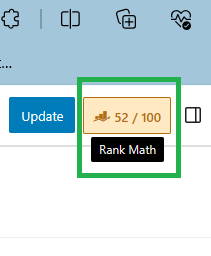
It breaks down improvement tips into four categories: Basic SEO, Additional, Title Readability, and Content Readability.
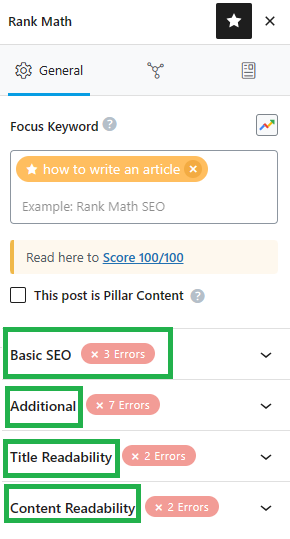
Click each dropdown to see where to improve.
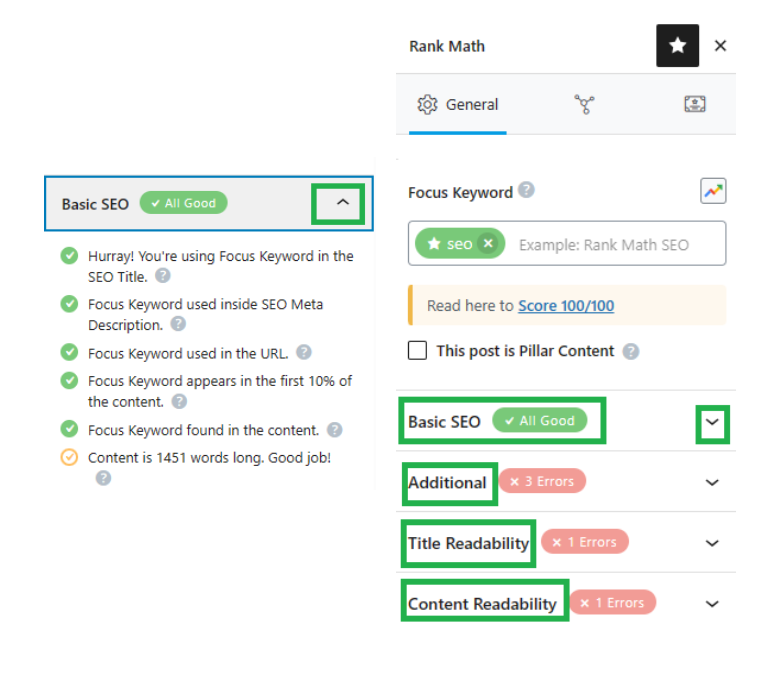
Similarly, there is also a button to open a separate webpage to select 'Inbound' links from other posts or pages on the website. The method of selecting the links is similar to selecting the outbound links described above.
B) Use LinkWhisper plugin to add links
When editing an article on our WordPress sites, you'll find the LinkWhisper plugin at the bottom of the page. It suggests relevant internal links, creating a cohesive network of related content. This enhances both SEO and user navigation.
Check the box to the left of the links you want to include and then click "insert links into post."
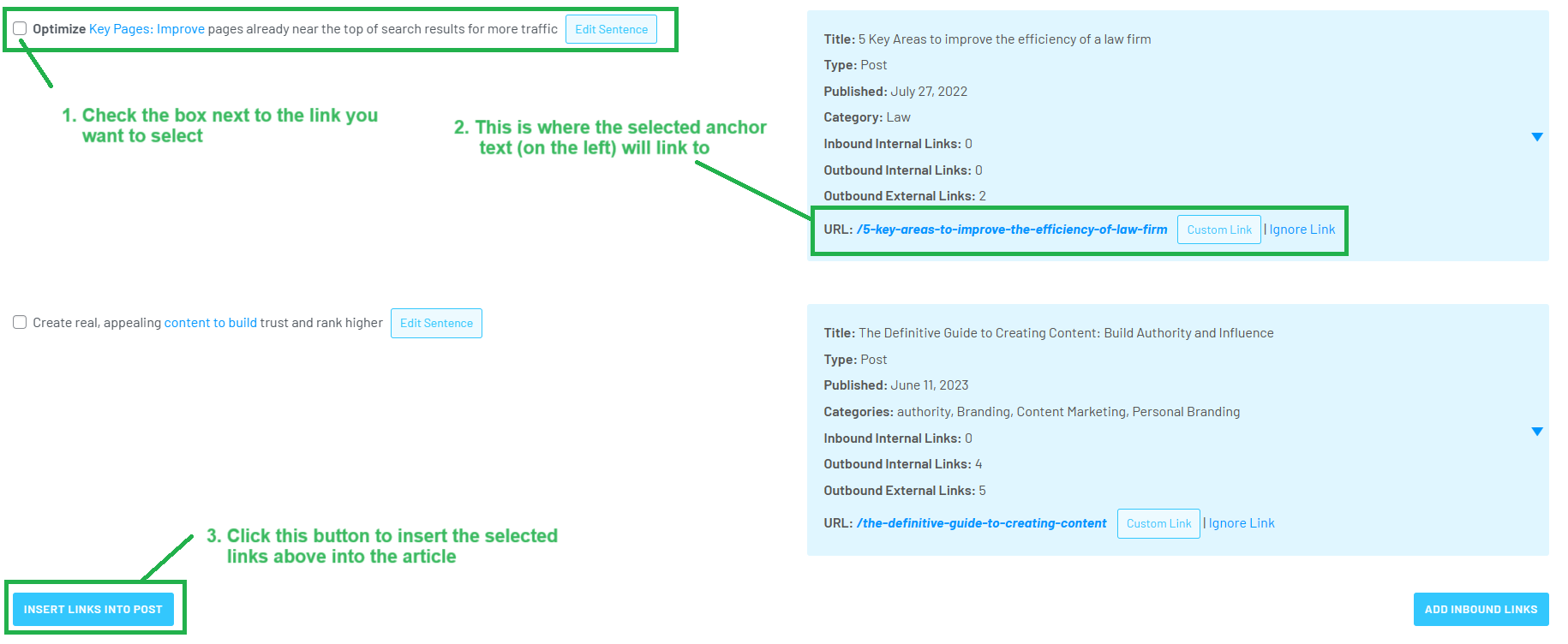
Additionally, there's a button that opens a separate page for choosing 'inbound' links from other website posts or pages, following a similar process.
13. Email and DM the client
After publishing an article that features a client’s business, it’s important to promptly inform them. Here’s how to do it efficiently and effectively:
How to Find the Client’s Contact Information
Look for it on Facebook, LinkedIn or Google by searching for the client’s name
Which Articles Should You Share?
- The article you just published and
- The article explaining how your article will help the client’s SEO: Hooray! Your SEO Improved With a DR62 Link From Us!
How to Compose Your Message
Write a clear and concise message to the client, celebrating their feature. Send this via email as well as Facebook messenger. Here is a message template that you can personalize:
Hi [Client's Name],
Great news! We've featured your business, [Website/Business/Company Name], on our DR62 website with a do-follow link.
To find out what this means for your website, read Hooray! Your SEO Improved With a DR62 Link From Us! - BlitzMetrics
Here is the link: [insert featured article link]
Looking forward to your feedback on the article.
Best,
[Your Name]
Content Team - BlitzMetrics
14. Post in our Facebook group
Write a brief, descriptive post to honor the client, with a link to the article you’ve just published, in our 43K Facebook group.
15. Important considerations
- Bold key statements. Italicize direct quotes.
- Keep the article concise. Trim unnecessary details.
- Organize with headings for easy navigation.
- Split long paragraphs to improve readability.
- Recap major points at the end, using bullets.
- Start with data or metrics, providing the story behind them to add context. Then suggest actionable strategies for improvement.
- Conclude with an invitation for feedback, such as “What are your thoughts?” or “Have you experienced this?” There are many ways to initiate a discussion, so experiment with a few and share your experiences with us. (Yes, this is another example of starting a conversation)
In the screenshot below, you can see that in the same ChatGPT article, the author wrote in bold the most important takeaway and added a summary of how AI can empower people with content libraries.

When Pulling From Transcripts To Create a Blog:
- Make sure you look the entire text over for a logical flow. Sometimes, if you're just following the transcript, you might take out language that might make sense to you but doesn't make sense in the written text.
- Pretend your reader doesn't know anything and doesn't want to spend time figuring out what you're talking about. Make everything super, super clear.
- When we're pulling from transcripts, clarity is particularly crucial. Make sure sentences are actually sentences and don't start and end in weird places.
- Also, don't be afraid to add to paragraphs to ensure clarity.
- Slowly read over each part of the document a few times, moving your finger along the screen if you have to, to find anything that might not make sense or is problematic from a sentence structure standpoint.
What To Do When Writing for Offsite Publications
- Look at the publication and try to understand what value the client can offer them.
- Look at past articles written by professionals and try to understand what type of articles the publication publishes.
- Notice how these articles are structured and look at the article guidelines (number of words, headings, etc.).
- Look at the content you have of the client (videos, his website).
- Come up with an angle and topic that matches the existing content at the publication.
- Focus on giving value to the reader of the publication. Again, this is very dependent on what it has already published. They know what their readers like to read.
How Long Should a Blog Be?
A blog should be concise yet comprehensive—short enough to avoid fluff, long enough to cover the subject. Length can vary. Small topics may need just 200 words, while larger ones can be up to 2,500 words. Include timestamps and other key elements for a quality blog post.
Where To Put Repurposed Content
When Dennis is interviewing successful entrepreneurs about their subject matter expertise and journey for CoachYu, place it on yourcontentfactory.com. The same is true for general digital marketing content since that's what Content Factory is all about.
Topical pieces will fit better on dennisyu.com-- like growing up Asian, adapting to the American opportunity, personal relationships, and thoughts.
General business pieces should go to free-ebooks.net/business.
That's it. You're done. Good job!
If you enjoyed this tutorial, then check our Task Library, and Ultimate Action Guide where you can learn how to get a thousand other things done!
Verification Checklist
- Checked for previous transcriptions of the video (pillar content).
- Confirmed the video hasn't been repurposed before.
- Watched the video to correct any errors in the transcription, including spelling.
- Properly named and stored the transcription file in Overdub Drive on Descript.
- Uploaded the transcription and video correctly to Google Drive.
- Sent the video for editing if not done by MarketScale.
- Embedded and clearly linked the source video or context in the article.
- Identified the goals, content, targeting (GCT) and made sure your article matches what you identified.
- Added images with correct captions and ensured they weren’t from Google or stock sites.
- Set and properly adjusted the featured image for the article preview.
- Ensured the article's first line is relevant and engaging.
- Confirmed there are no other articles targeting the same keyword.
- Ensured all links in the article work and are relevant.
- Made sure there are no duplicate links.
- Avoided linking to general top-level domains unless required (e.g. affiliate, partner, or client sites).
- Used specific anchor texts which are not broad terms and ensured there are no naked links.
- Wrote in simple language and active voice.
- Followed spelling and grammar rules using tools like Grammarly.
- Avoided mentioning dates or events to keep the article timeless.
- Ensured the article is at least 200 words.
- Organized the article with clear headings (H2s) and kept paragraphs short (5 lines or less).
- Used tools like Surfer for heading analysis or checked manually for heading abuse.
- Wrote a catchy headline that explains the content.
- Proofread the article using tools like ChatGPT.
- Used SEO tools like RankMath and LinkWhisper for easy article findability and proper linking.
- Categorized and tagged the article in WordPress.
- Made sure the URL slug matches the article title.
- Emailed the client with the article's link and also posted it in the 43K Facebook group.
- Adhered to the preferred article type, structure and format guidelines for offsite publications.
- Concluded the article with bullet point summaries and invited readers to comment.
